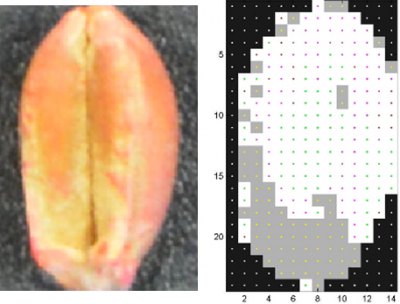
The Winter 2017/2018 edition of CRA-W Info, the newsletter of the Wallon Agricultural Research Center, reports on the use of near infrared (NIR) hyperspectral imaging for the control of the addition of chemicals to seeds. The treatment of seeds with plant protection products is strongly recommended to fight different plant diseases and pests in the early stages of plant growth, but which analytical methods are available to control the dose and homogeneity of the treatment on a seed lot?
New seed treatment products are effective at very low doses, and effective treatment requires the application of the active ingredient at the correct dose according to the species, the variety and the health status of the lots. Too low a dose may lead to insufficient protection of the plant, while too high a dose could increase the risk of phytotoxicity. Further, the active ingredient must be evenly distributed not only between the seeds in a lot but also on the surface of the seeds, including the groove.
The reference methods used to control the quality of seed treatment are chromatographic methods, which are time-consuming, costly, destructive and difficult to use in routine controls. NIR spectroscopy does not have these problems and can be used to identify the active ingredients and their average dosage on a seed lot or individual seeds with adapted sample presentation devices. Near infrared hyperspectral imaging allows the analysis of several seeds simultaneously while assessing the dose and homogeneity of the treatment on each seed. A study carried out by Pauline Flémal (Université catholique de Louvain, Belgium) within the framework of her thesis, revealed the potential of this technology combined with chemometrics to control the quality of seed treatment.
The results of the analysis of treated seeds on an average dosage by UHPLC and NIR spectroscopy showed a high level of variability between lots treated with the same formulation, from different seed producers. Regarding barley, the active ingredient content in 85% of samples was less than 70% of the target dose.
Thanks to NIR hyperspectral imaging, it was also possible to detect the potential presence of seeds from another species/variety in a seed lot, untreated seeds or seeds treated with a different formulation. It was also possible to assess the homogeneity of the treatment on each seed individually and to classify them according to the target dose. For some lots, the active ingredient content in more than 75% of the seeds was higher than the acceptable 30% around the target dose.
This technology opens up new opportunities in terms of seed quality control. This study was published in the Journal of Spectral Imaging (doi: 10.1255/jsi.2017.a1).










